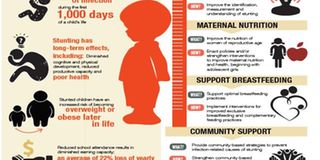When a child has malnutrition, every second counts

What you need to know:
Nearly half of all deaths in children under 5 can be attributed to undernutrition. This translates into the unnecessary loss of about 3 million young lives a year.
Four young new mothers lay on the hospital bed at Shinyanga regional hospital’s maternal ward, sharing a light moment with their new-borns. The nurses are spotted moving from one corner to the other, making sure everything is under control.
The room has large windows to allow natural sunlight and fresh air in. Seated on a bench by the beds in the maternal ward is 57-year-old farmer Njile Chaba with her granddaughter Patricia. Patricia who is 19-months-old suffers from stunting; a form of malnutrition that impairs growth and development that children experience from poor nutrition or sometimes repeated infection.
The maternal ward that Patricia is undergoing treatment at also treats children suffering from tuberculosis (TB), diarrhoea and malnutrition – few among the most common ailments affecting children below 5 years in Tanzania.
But most of the beds at the ward are vacant. “Other patients have been discharged a few days ago. Their condition had improved. Only a few patients have been admitted for further treatment,” says Zainab Juma, an enrolled nurse at the hospital.
The grandmother and granddaughter duo were at the hospital that day to attend their monthly nutrition clinic session.
Speaking to Your Health during a recent visit at the hospital, Ms Chaba says that she doesn’t miss out on these sessions because they have been significant in improving Patricia’s health.
Two months ago, Patricia was abandoned by her mother after her parents decided to separate. “Zawadi [Ms Chaba’s daughter-in-law] brought her daughter to me, but she never came back and I don’t know where she is. Patricia was not in a good condition at all,” Ms Chaba tells.
The grandmother who barely speaks Kiswahili, but fluent in Sukuma—spoken in an area southeast of Lake Victoria between Mwanza, Shinyanga and Lake Eyasi—recalls that back in June this year, when Patricia was brought, she was very weak and malnourished. Ms Chaba sought to seek medical help and that’s when she was referred to Shinyanga Regional Hospital for treatment.
Severe acute malnutrition, or very low weight for one’s height is the most extreme and visible form of undernutrition, and severely impacts child survival and long-term well-being.
In Tanzania, 34 per cent or 3.3 million children under-5 years suffer from chronic malnutrition (stunting or low height-for-age) and 58 per cent or 5.6 million suffer from anaemia as per data from the Tanzania Demographic and Health Survey and Malaria Indicator Survey (TDHS-MIS) 2015-2016.
Ms Chaba further recalls her granddaughter as being “inert” when they had arrived at the regional hospital for the first time. “I didn’t think she would make it,” she adds.
The results at the hospital showed that Patricia suffered from severe malnutrition accompanied by diarrhoea.
“The doctor said my granddaughter was underweight and weak due to undernutrition,” says Ms Chaba.
Ms Nyachiro Mujaya, a registered nurse at Shinyanga regional hospital who attended Patricia when they arrived at the hospital on the first day says Patricia was weighing 5 kilograms--considered very low weight and therefore she prescribed her to eat foods high in energy and nutrients.
“Parents are feeding their babies with dried foods that don’t have enough nutrients, as a result, the babies are completely malnourished,” says Ms Mujaya.
“We normally provide the malnourished babies with milk and nuts, but we first diagnose the stage of their condition. The medication also depends on the baby’s age and weight,” she adds.
It took a few weeks before Patricia began to recover. She is now growing well, currently weighing 7.4 kilograms; however, she is still undergoing treatment for malnutrition at the regional hospital.
Causes of childhood malnutrition
Health experts indicate that inadequate food intake, infections, psychosocial deprivation, the environment (lack of sanitation and hygiene), social inequality and genetics contribute to malnutrition in children.
Ms Mujaya is one among the 55 health providers in the region who have received comprehensive training on malnutrition under the USAID Boresha Afya project aimed at enhancing the providers’ capacities in addressing malnutrition in children.
The project is supported by USAID, led by Jhpiego partnering with, PATH, EngenderHealth and the government of Tanzania to increase access to high-quality, comprehensive and integrated health services through a package encompassing reproductive, malaria, maternal, new-born child and adolescent health services.
“The project is implemented in line with the health ministry’s Integrated Management of Childhood Illness (IMCI) guidelines,” says Dr Suka Charles, regional project coordinator.
Referring to the positive impacts of the project, regional nutrition officer for Shinyanga, Dennis Madeleke, highlights that 450 malnourished children received treatment in the region between January and June this year.
However, he acknowledges that the shortage of therapeutic foods— prepared foods that contain calories, vitamins and minerals for specific nutritional needs -- at the public health facilities is the key challenge, citing that the situation is attributable to the fact that the aforementioned foods are manufactures abroad.
“Prevalence of malnutrition in Shinyanga is still high, hence redoubling of efforts is necessary to curb the burden,” says Mr Madeleke.
The burden of malnutrition is unacceptably high
The 2018 Global Nutrition Report states that the burden of malnutrition across the world remains unacceptably high, and progress unacceptably slow. Malnutrition is responsible for more ill-health than any other cause. Children under five years of age face multiple burdens: 150.8 million are stunted, 50.5 million are wasted and 38.3 million are overweight. Meanwhile, 20 million babies are born of low birth weight each year.
Beyond health, slow progress on malnutrition is also impacting the social and economic development of countries.
It is estimated that malnutrition in all its forms could cost society up to $3.5 trillion per year, with overweight and obesity alone costing $500 billion per year.
The report further states that women have a higher burden than men when it comes to certain forms of malnutrition. “One-third of all women of reproductive age have anaemia and women have a higher prevalence of obesity than men. Millions of women are still underweight,” the report further says.
Progress to date is simply not good enough
Significant steps are being made to address malnutrition. Globally, stunting among children under five years of age has fallen from 32.6 per cent in 2000 to 22.2 per cent in 2017. There has been a slight decrease in underweight women since 2000, from 11.6 per cent to 9.7 per cent in 2016. Yet, while there has been progressing, it has been slow and patchy.
The 2018 assessment of progress against nine targets reveals only 94 of 194 countries are on track for at least one of the nine nutrition targets assessed. This means that most countries are significantly off-track on meeting all nine targets.
Situation in Tanzania
Tanzania is listed among the examples of countries building multisectoral plans to deliver on their targets in improving nutrition among children under 5 years of age. A wide range of targets has been adopted – seven in all, including for stunting, anaemia and low birth weight. These targets form part of an ambitious five-year action plan to reduce multiple burdens of malnutrition.
The plan was set up under the direct leadership of the Prime Minister’s office to reduce all forms of malnutrition associated with both deficiency and imbalances.
Its broad goal is to scale up high-impact interventions among the most vulnerable people, including children under five years of age, adolescent girls and pregnant and lactating women. It does this by calling for action across sectors, from social protection to education and food.
“All regional commissioners have been instructed to effectively supervise the outreach campaigns designed to curb malnutrition in their respective areas,” says Dr Faustine Ndugulile, Deputy Minister of Health, Community Development, Gender, Elderly and Children.
He adds that the government has embarked on conducting research works to come up with comprehensive strategies to reduce malnutrition burden in the country. “Tanzania is on the right track when it comes to the availability of nutritious foods, but majority of the people lack education on nutrition, hence the burden persists,” he adds.
Breastfeeding
Breastfeeding within the first hour after birth is critical for saving newborn lives.
Despite the importance of early initiation of breastfeeding, too many newborns are left waiting too long for different reasons, as an estimated 78 million babies globally– or three in five – are not breastfed within the first hour of life, putting them at higher risk of death and disease and making them less likely to continue breastfeeding, say United Nations Children Fund and World Health Organisation in their joint report titled, “Capture the Moment: Early initiation of breastfeeding – the best start for every newborn”.
Capture the Moment, which analyses data from 76 countries, finds that newborns who breastfeed in the first hour of life are significantly more likely to survive. Even a delay of a few hours after birth could pose life-threatening consequences. Skin-to-skin contact along with suckling at the breast stimulate the mother’s production of breastmilk, including colostrum, also called the baby’s ‘first vaccine’, which is extremely rich in nutrients and antibodies.




